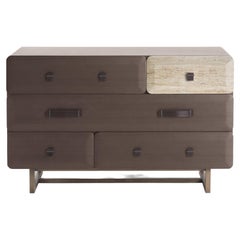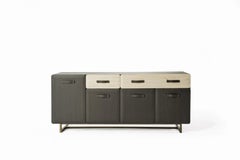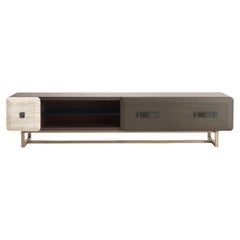Gianfranco Ferre Home Five Points
21st Century Five Points Chest in Wood by Gianfranco Ferré Home
By Gianfranco Ferre Home
Located in Cantù, Lombardia
materials for furniture with a metropolitan and unconventional charm.
The Five Points chest of drawers with
Category
21st Century and Contemporary Italian Modern Commodes and Chests of Drawers
Materials
Metal
$32,970 / item
H 31.89 in W 51.19 in D 19.69 in
21st Century Five Points Sideboard in Tay Wood by Gianfranco Ferré Home
By Gianfranco Ferre Home
Located in Cantù, Lombardia
materials for furniture with a metropolitan and unconventional charm.
Five points sideboard with structure
Category
21st Century and Contemporary Italian Modern Sideboards
Materials
Metal
$45,500 / item
H 37.01 in W 86.62 in D 20.48 in
21st Century Five Points TV Holder in Tay Wood by Gianfranco Ferré Home
By Gianfranco Ferre Home
Located in Cantù, Lombardia
materials for furniture with a metropolitan and unconventional charm.
Five Points TV holder with Structure
Category
21st Century and Contemporary Italian Modern Music Stands
Materials
Metal
$25,070 / item
H 17.72 in W 78.75 in D 16.15 in
People Also Browsed
Mario Bellini "Pianura" Sofa for Cassina, 1971, Set of 5
By Mario Bellini, Cassina
Located in Lonigo, Veneto
Mario Bellini "Pianura" modular sofa for Cassina, brown mohair velvet and wood, Italy, 1971, five elements.
The “Pianura” living room set is a great expression of the minimalism and...
Category
Vintage 1970s Italian Mid-Century Modern Sectional Sofas
Materials
Velvet, Wood
$34,000 / set
H 25.99 in W 167.72 in D 36.23 in
Charlotte Perriand Dining Chairs for Robert Sentou, 1964, Set of 10
By Robert Sentou, Charlotte Perriand
Located in Lonigo, Veneto
Charlotte Perriand Dining Chairs for Robert Sentou, straw and wood, France, 1964, set of ten.
The chairs have a simple and timeless design. The fancy backrest and seat in straw com...
Category
Vintage 1960s French Mid-Century Modern Chairs
Materials
Straw, Wood
$27,500 / set
H 30.71 in W 19.1 in D 17.33 in
Customizable Modern Cabinet Carmen, Solid wood, Mirror and natural fibers
By Comité de Proyectos
Located in Ciudad de México, CDMX
Carmen is a bartender, a storage cabinet with a functional design. Inside, it has a pair of drawers for storing objects, space for bottles, compartments for glasses and a cup holder...
Category
2010s Mexican Modern Armchairs
Materials
Upholstery, Hardwood
$8,674 / item
H 43.31 in W 17.72 in D 35.44 in
Long brass chandelier in Murano glass by Studio Glustin
By Glustin Creation
Located in Saint-Ouen (PARIS), FR
Long brass chandelier with sculpted Murano glass.
Italy, 2024.
Category
21st Century and Contemporary Italian Mid-Century Modern Chandeliers and...
Materials
Brass
$10,115 / item
H 35.44 in W 59.06 in D 15.75 in
"Il Pezzo 1 Credenza" sideboard in solid walnut - marble top - brass base
By Il Pezzo Mancante
Located in Firenze, IT
An alternation of rounded shapes and geometrical lines, reassuming discipline and freedom, a composite, multiethnic plan in which each component and each material contributes to the ...
Category
2010s Italian Modern Credenzas
Materials
Marble, Gold, Brass
$11,801 / item
H 32.68 in W 100.4 in D 15.75 in
Mid-Century Modern Dornes Side Table, Walnut Brass, Handmade by Greenapple
By Greenapple
Located in Lisboa, PT
Mid-Century Modern Dornes Side Table, Contemporary Collection, Handcrafted in Portugal - Europe by Greenapple.
The Dornes side table was crafted to tell a story of scenic beauty, em...
Category
21st Century and Contemporary Portuguese Mid-Century Modern Coffee and C...
Materials
Brass, Stainless Steel
$3,853 / item
H 17.72 in W 18.12 in D 17.72 in
Vladimir Kagan Zoe Sofa for American Leather in Curly Teddy Bear Camel Fabric
By Vladimir Kagan, American Leather
Located in Saint Louis, MO
Everyone needs a teddy bear and yours can be this chic Vladimir Kagan Zoe sofa newly upholstered in soft curly camel teddy bear fabric. Modern. In your face sexy. Super soft teddy be...
Category
21st Century and Contemporary American Post-Modern Sofas
Materials
Upholstery
$12,800
H 30.25 in W 92 in D 42 in
Mario Marenco "Sapporo" Chairs for Mobil Girgi, Reddish Brown, 1970, Set of 4
By Mobil Girgi, Mario Marenco
Located in Lonigo, Veneto
Mario Marenco "Sapporo" chairs for Mobil Girgi, reddish brown leather and beech, Italy, 1970, set of four.
The iconic "Sapporo" chair consists of a particular backrest, conceived wi...
Category
Vintage 1970s Italian Mid-Century Modern Dining Room Chairs
Materials
Leather, Beech
$10,800 / set
H 32.09 in W 19.69 in D 20.87 in
Soda Blown Murano Glass High Coffee Table in Petrol by Yiannis Ghikas
By Miniforms, Yiannis Ghikas
Located in Brooklyn, NY
Soda was born upside-down, with a puff of air. It weighs 20 kilos, and it is blown, drawn out and shaped by three master glassmakers. The result is a single volume of glass with thre...
Category
21st Century and Contemporary Italian Modern Coffee and Cocktail Tables
Materials
Blown Glass
$2,500 / item
H 17.72 in Dm 14.97 in
Large Italian Bookcase in Walnut, Cherry, and Grasscloth
Located in Waalwijk, NL
Library, walnut, cherry, grasscloth, Italy, 1950s
This delightful bookcase reflects the design principles of the Mid-Century era that rose to prominence in the 1950s and 1960s. The ...
Category
Vintage 1950s Italian Mid-Century Modern Bookcases
Materials
Cherry, Walnut, Grasscloth
Mawu Chair in Snow by Laura Gonzalez
By laura gonzalez
Located in Paris, FR
Original chair in golden oak, satin finish. Flared legs, backrest and seat upholstered in a textured cream fabric by Dedar.
Category
2010s French Modern Chairs
Materials
Oak, Fabric, Bouclé
Classic by Giuseppe Carpanelli Gran Confort Office Armchair in leather
By Carpanelli
Located in Desio, IT
This armchair has an unusual elliptic curved outline with slatted solid wood structure, the backrest frame is made of solid walnut, while the swivel base is fitted with a height and ...
Category
21st Century and Contemporary Italian Neoclassical Office Chairs and Des...
Materials
Leather, Fabric, Velvet, Faux Leather, Wood
$5,759 / item
H 42.52 in W 29.53 in D 28.35 in
Yumi Stool by Modu Studio
By Modu Studio
Located in New York, NY
The Yumi Stool is a handcrafted piece of furniture that combines solid wood and liquid bronze for a unique appearance. The stool is made using traditional techniques such as hand car...
Category
2010s American Stools
Materials
Bronze
Vittorio Wardrobe in Black Ash Wood and velvet interior
By Gio Pagani
Located in Milano, IT
The Vittorio wardrobe is a modular storage unit, available in two versions, 60 cm and 120 cm wide, which can be placed side by side.
The structure in sandblasted black ash wood is en...
Category
2010s Wardrobes and Armoires
Materials
Leather, Ash
Large Sculptural curved edge travertine rectangle dining table
Located in AMSTERDAM, NL
A functional sculpture of the room. This organic modern minimalist table is made from tumbled travertine, featuring a thick table top with curved edges that elegantly sits on a curve...
Category
2010s Organic Modern Dining Room Tables
Materials
Travertine
$10,235 / item
H 29.53 in W 86.62 in D 35.44 in
Large Solid Stone Green Marble Oval Dining Table with Bellini style Column Legs
By Mario Bellini
Located in AMSTERDAM, NL
This minimalist table is crafted entirely from stone, featuring an oval horse-track top in green marble with elegant white veining. It rests on four cylindrical columns that taper in...
Category
2010s Portuguese Mid-Century Modern Dining Room Tables
Materials
Stone, Limestone, Travertine, Marble
$9,633 / item
H 29.53 in W 39.38 in D 94.49 in
Get Updated with New Arrivals
Save "Gianfranco Ferre Home Five Points", and we’ll notify you when there are new listings in this category.
More Ways To Browse
Giant Shoe
Gilt Bronze Fish
Glass And Chrome Fireplace Screen
Glass Balls
Glass Divided Dinner Plates
Glass Fruit And Vegetables
Glass Heater
Glass Love Birds
Glass Nude Woman Sculpture
Glass Peacocks
Glass Piggy Bank
Gli Etruschi Ivo De Santis
Globe Ice Bucket
Godinger Silver Plated
Gold And Black Dresser
Gold Beaker
Gold Gilt Etagere
Gold Leaf Headboard


